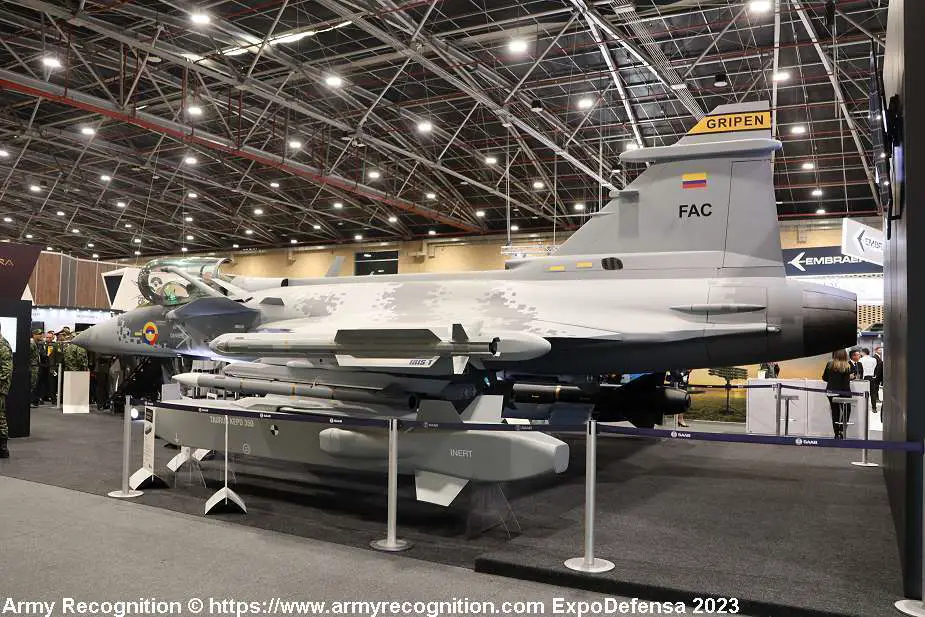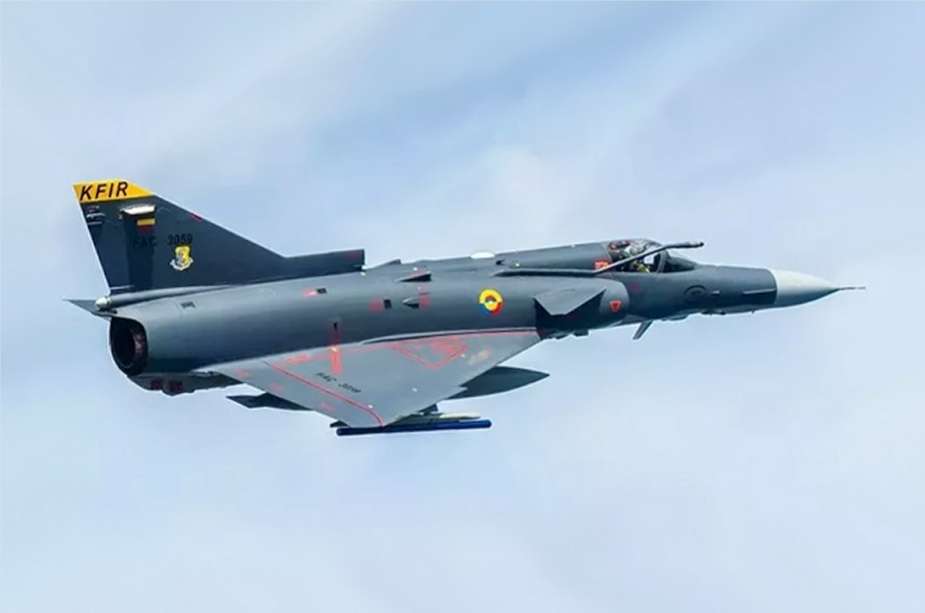Breaking news
ExpoDefensa 2023: Gripen full-scale model marks Saab's effort to win Colombian Kfir replacement.
Saab, the Swedish defense company, is participating in ExpoDefensa 2023 with a focus on presenting a solution to replace the aging Israeli-made Kfir combat aircraft. The centerpiece of their showcase is a full-scale replica of the Gripen multirole-fighter aircraft, a key asset in Saab's bid for a contract with the Colombian Air Force.
Follow Air Recognition on Google News at this link
 In addition to the Gripen replica, Saab is showcasing high-fidelity simulators for both the Gripen fighter and the RBS 70 NG air defense system (Picture source: Army Recognition)
In addition to the Gripen replica, Saab is showcasing high-fidelity simulators for both the Gripen fighter and the RBS 70 NG air defense system (Picture source: Army Recognition)
In addition to the Gripen replica, Saab displayed high-fidelity simulators for both the Gripen fighter and the RBS 70 NG air defense system at the exposition in Colombia. Saab's engagement with Colombia extends beyond the exhibition floor. In 2022, the company entered a partnership with CODALTEC, focusing on virtual reality to enhance flight simulation realism. This collaboration aims to create a more authentic training environment for Gripen E/F fighter pilots and forms the basis for developing simulation software integral to Saab's offer to the Colombian Air Force.
Pierre Farkas, Saab Colombia's executive director, emphasized the company's dedication to Colombia's defense needs. Farkas highlighted the potential Gripen acquisition as more than securing a modern and cost-efficient combat aircraft. It is seen as an opportunity for collaboration, technology sharing, job creation, and sustainable growth. Saab's strategy aligns with Colombia's mandate, ensuring tangible benefits for the local industry accompanying the acquisition of defense equipment. Saab has forged partnerships with Colombian universities, the CIAC, and CODALTEC for knowledge transfer and technology localization.
Beyond the exhibition, Saab showcases a diverse portfolio at ExpoDefensa 2023, spanning maritime, land, and air systems. Products include the Gripen fighter plane, the RBS 70 NG air defense system, Giraffe Radars, Electronic Warfare Systems, 9LV Naval Combat Management System, and the Submarine A26.
As of 2022, the Colombian Air Forces operate a fleet of 22 Kfir aircraft, comprising 10 Kfir C-10, 9 Kfir C-12, and 3 Kfir TC-12 variants, highlighting the urgency and significance of finding a suitable replacement. Saab's Gripen emerges as a candidate for this role.
The Israel Aircraft Industries (IAI) Kfir, developed in the 1970s, originated from the Israeli Air Force's need to enhance the Dassault Mirage IIICJ's ground-attack capabilities due to its limited range. The Mirage IIICJ, acquired from France, served as the basis for the Kfir, which aimed to address these shortcomings.

A Colombian Air Force Kfir, assigned to the 111th Combat Squadron, over Rionegro, Colombia, in 2014. (Picture source: Wikimedia)
The Kfir, powered by the General Electric J79 turbojet engine, featured modifications to the airframe and internal fuel tank arrangement for increased capacity. The Ra'am B prototype showcased revised cockpit features, strengthened landing gear, and Israeli-built avionics. The Kfir C7 variant specifications include a length of 15.65 m, a wingspan of 8.22 m, and a height of 4.55 m, with a maximum takeoff weight of 16,500 kg. The IAI Bedek-built General Electric J79-J1E turbojet engine enables a maximum speed of 2,440 km/h (Mach 2.3) and a combat range of 1,000 km or 670 km, depending on configuration. The armament includes two Rafael-built 30 mm DEFA 553 cannons, air-to-ground rockets, and air-to-air missiles.
The Kfir has various variants, such as the Kfir C.10 with adaptations like the Elta EL/M-2032 radar for export and the Kfir TC.10, an upgraded version for the Colombian Aerospace Force. Another variant, the Kfir C.12, developed for Colombia, is based on the C.7 but lacks the Elta EL/M-2032 radar. The Kfir demonstrates adaptability through its diverse configurations, addressing specific operational requirements for different users.
Contrasting the Kfir, the Saab JAS-39 Gripen E-series, with a heritage dating back to the late 1980s, is a versatile fighter aircraft that has been in operational use since 1996. Employed by various air forces, including those of Sweden, Brazil, South Africa, and Hungary, the Gripen E/F series features an electronic warfare suite with jamming capabilities and countermeasures. Its secure data-linking system enables communication with other aircraft and ground stations, and advanced sensor systems, such as an Infrared Search and Track (IRST) system, contribute to its target detection capabilities.
Equipped with modern avionics, the Gripen E/F series incorporates a "Wide Area Display" (WAD), a large touchscreen developed by AEL Sistemas, aimed at enhancing pilot situational awareness and ease of operation. Recognized as a "swing-role combat aircraft," it emphasizes reliability and the ability to operate with minimal personnel and ground support equipment for decentralized operations. The aircraft's adaptability to operate from compact, unprepared landing strips further enhances its tactical flexibility.
In terms of design and specifications, the Gripen E has a length of 15.2m, a wingspan of 8.6m, and a maximum takeoff weight of 16,500kg. Achieving a maximum speed of Mach 2 at high altitude, it features ten pylon stations for carrying various payloads, including reconnaissance pods, weapons, and external fuel tanks. The internal fuel tanks have been expanded, providing a 40% increase in capacity compared to its predecessor.
Armed with a variety of air-to-air and air-to-surface weapons, including missiles, guided bombs, and a 27mm Mauser BK27 high-velocity gun, the Gripen E is designed to fulfill diverse mission requirements. Its Selex ES-05 Raven AESA radar system offers a wide field of view and look-behind capability. The inclusion of an Infrared Search and Track (IRST) sensor, an advanced electronic warfare (EW) system, and communication systems like ROVER and Link 16 further contribute to its capabilities. Powered by the General Electric F414G engine, the Gripen E achieves supersonic speeds without using an afterburner, enhancing fuel efficiency and mission endurance.


























